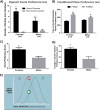Sex-dependent regulation of social reward by oxytocin receptors in the ventral tegmental area
- PMID: 30467338
- PMCID: PMC6372681
- DOI: 10.1038/s41386-018-0262-y
Sex-dependent regulation of social reward by oxytocin receptors in the ventral tegmental area
Abstract
Social reward is critical for social relationships, and yet we know little about the characteristics of social interactions that are rewarding or the neural mechanisms underlying that reward. Here, we investigate the sex-dependent role of oxytocin receptors within the ventral tegmental area (VTA) in mediating the magnitude and valence of social reward. Operant and classical conditioning tests were used to measure social reward associated with same-sex social interactions. The effects of oxytocin, selective oxytocin receptor agonists, antagonists, and vehicle injected into the VTA on social reward was determined in male and female Syrian hamsters. The colocalization of FOS and oxytocin in sites that project to the VTA following social interaction was also determined. Females find same-sex social interactions more rewarding than males and activation of oxytocin receptors in the VTA is critical for social reward in females, as well as males. These studies provide support for the hypothesis that there is an inverted U relationship between the duration of social interaction and social reward, mediated by oxytocin; and that in females the dose-response relationship is initiated at lower doses compared with males. Same-sex social interaction is more rewarding in females than in males, and an inverted U relationship mediated by oxytocin may have a critical role in assigning positive and negative valence to social stimuli. Understanding these sex differences in social reward processing may be essential for understanding the sex differences in the prevalence of many psychiatric disorders and the development of gender-specific treatments of neuropsychiatric disorders.
Figures





References
Publication types
MeSH terms
Substances
Grants and funding
- MH110212/U.S. Department of Health & Human Services | NIH | National Institute of Mental Health (NIMH)/International
- R21 MH109302/MH/NIMH NIH HHS/United States
- F31MH113367/U.S. Department of Health & Human Services | NIH | National Institute of Mental Health (NIMH)/International
- R01 MH110212/MH/NIMH NIH HHS/United States
- P51 OD011132/OD/NIH HHS/United States
LinkOut - more resources
Full Text Sources

